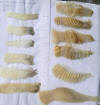Staple is a term referring to naturally formed clusters or locks of wool fibers throughout a fleece that are held together by cross fibers. The staple strength of wool is one of the major determining factors when spinning yarn as well as the sale price of greasy wool.
Virtually all fleece and better grade wool skirtings sold at auction in Australia are objectively measured prior to the sale with the average results printed in a catalogue.
Staple strength is calculated as the force required to break per unit staple thickness, expressed as newtons per kilotex or N/tex. Position of Break (POB) is measured in conjunction with staple strength and is a measure of the position in the staple (base, mid or tip) where it will break given enough force. Forty or more staples must be measured to in order to conform to the Australian Standard. Wools under 30 newtons per kilotex are considered tender. Currently wools over 40 newtons per kilotex are preferred and attract a premium. Seasonal conditions or the health of the sheep may influence the soundness (strength) of the wool.
The Australian Standard requires that sale lot has a minimum of 55 staples measured with the average calculated and produced. The variability of this measure is reported as the coefficient of variation (CV%). Staple length generally determines the end use of wool, that is, whether it will be used in weaving or knitting. The longer wools are processed in the worsted system (weaving), which are called combing types, and are generally around 51 millimeters (mm) and longer. Short stapled wools are more profitably used in the woolen section where high grade material may be produced from superfine wool. Staple length (mm) is highly correlated with mean fiber length in the top (hauteur).
Although traditionally, staple length only referred to animal fibers, it is now used when referring to animal and manufactured fibers as well.
The opposite term is filament fiber, which is fiber that comes in continuous to near continuous lengths for use. Silk, taken from the cocoon of a silkworm, is called a silk filament.

